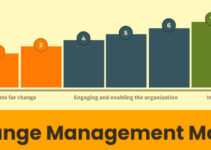Change management engagement is the process of complete involvement of employees in the change initiative strategy. Employee engagement in the change strategy plays a key role in the growth and success of the change project. Today, we’ll discuss the change management engagement plan; benefits, channels, and steps involved in the process of employee engagement plan for change management.
Benefits of Change Management Employee Engagement
- Amplifies the success rate of the change strategy
- Increases the acceptance and adoption rate of employees impacted by the change
- Engaged and fully involved employees appreciate the company’s efforts in transformation
- Comprises of engaging impacted employees and stakeholders in the change project to increase the adoption rate
Channels of Employee Engagement for Change Management
- One-on-one interaction
- Town hall meeting
- Digital platform
- Workshops
- Newsletters
- Informational pamphlets
- Employee references
- Digital media platforms
- Email campaigns
- Collaborative platforms
- Interactive forums
- FAQs
- Regular updates
Change Management Engagement Plan – Steps
Let’s discuss the main steps involved in the change management engagement plan; they’re as follows;
Recognizing Impacted Division or Unit
First of all, the company’s management and leadership should comprehend and recognize the key departments, groups, and units impacted by the change project. They should also perform impact analysis on the affected department. While doing so, they should gather feedback from sponsors, SMEs, stakeholders, and teams.
Identifying Impacted Stakeholders
After recognizing the affected groups; they should also identify the key individuals, employees, and stakeholders affected by the change project. The audience analysis allows them to precisely know the number of affected individuals and stakeholders. When you are aware of the affected people, then you could target them precisely in your communication message.
Communication Engagement Channels
Speaking of communication, the management could employ multiple communication channels to connect and engage with the affected end-users. While choosing the communication channel, it is necessary to select the right communication channel that would rightly deliver the change message to the right audience. You should keep in mind the following factors;
- Nature of message; whether it is personal or professional you need to do it publically or personally
- Total number of affected individuals and employees
- The resistance level of employees
- Location
- The objective of communication or engagement that you want to achieve
Prioritizing
When it comes to communicating the change message, it is important to prioritize the audience to whom you would deliver the change message and communicate first. While prioritizing the targeted affected audience, you should keep in mind the following factors;
- Severity level impact on the affected group
- Their resistance level to the changes
- Beware of the nature of the message and choose the right channel
It depends on the change type and management decisions. Often, companies start with the lowest impacted units and groups that have a limited resistance level, and then move up to the highest impacted groups; vice versa
Recognizing Early Change Adopters
There are some employees who would immediately accept the changes and respect the company’s transformational plan. The leadership should recognize those individuals and include them in its team. It is because they’re going to help you in conducting change engagement and communication sessions and meetings; and support the change project.
Customized Content for Impacted Individuals
The leadership should develop customized content communication and engagement material for all the affected employees. It allows them to connect with them personally, and let them know how the change plan would impact their roles and responsibilities. The message has to be precise, and it should precisely deliver the right message that the company wants with no double meaning.
Upcoming Event Notification
Throughout the whole process, the company should collaborate with change managers, early adopters, and affected employees back and forth and answer their queries and questions. The company and change leaders should be clear about the change project and know the objectives that they plan to achieve with it. The leadership should send messages or call notifications to all the employees about the upcoming event or their meeting time and date with the management.
Implementing Engagement
The communication and engagement session could be one-on-one or group meetings. The change managers and the company’s leadership should communicate the change message and answer their questions. It is significant to mention here that the employees feel good if they hear directly from the top management. The leadership should assure them that the change is for the good of the organization and for their personal benefit.
Follow-up Engagement
After implementing the changes and communicating with employees; change managers and leadership should have a follow-up communication and engagement session with employees. The objective is to let them know that the management is on board and stands beside them throughout the change plan. However, it boosts their morale and confidence level.
Providing Support
The follow-up session lets the management about the required support that the employees need for the effective implementation of the changes. Providing them with sufficient support would ensure the success of the change project.
Conclusion: Change Management Engagement Plan |Change Management Employee Engagement Plan | Change Engagement Plan
After an in-depth study of the change management engagement plan; we have realized that employee engagement plays a key role in the change project. If you are learning about employee engagement for change management; then you should keep in mind the abovementioned benefits, channels, and steps involved in the change engagement plan.
Ahsan is an accomplished researcher and has a deep insight in worldly life affairs. He goes Live 3 days a week on various social media platforms. Other than research writing, he’s a very interesting person.


